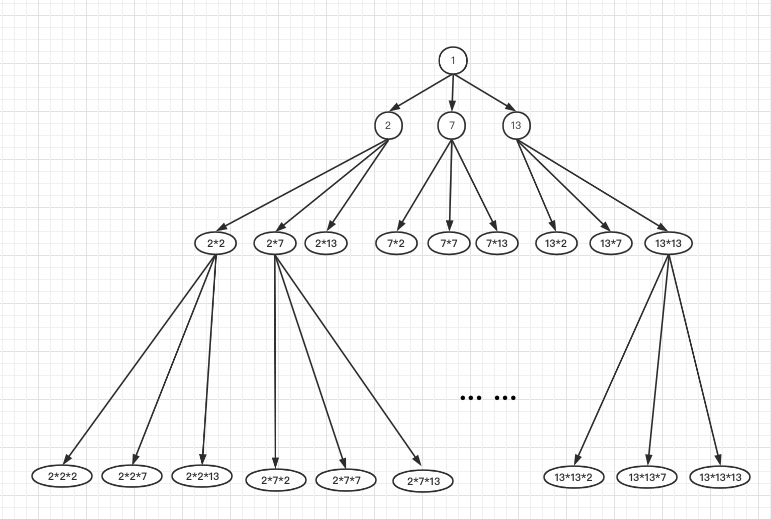

算法题 LEECODE 313. 超级丑数
source link: http://vearne.cc/archives/39375
Go to the source link to view the article. You can view the picture content, updated content and better typesetting reading experience. If the link is broken, please click the button below to view the snapshot at that time.

版权声明 本站原创文章 由 萌叔 发表
转载请注明 萌叔 | http://vearne.cc
来源:力扣(LeetCode)
链接:https://leetcode-cn.com/problems/super-ugly-number
编写一段程序来查找第 n 个超级丑数。超级丑数是指其所有质因数都是长度为 k 的质数列表 primes 中的正整数。
输入: n = 12, primes = [2,7,13,19]
输出: 32
解释: 给定长度为 4 的质数列表 primes = [2,7,13,19],前 12 个超级丑数序列为:[1,2,4,7,8,13,14,16,19,26,28,32]。
说明:
1 是任何给定 primes 的超级丑数。
给定 primes 中的数字以升序排列。
0 < k ≤ 100, 0 < n ≤ 106, 0 < primes[i] < 1000 。
第 n 个超级丑数确保在 32 位有符整数范围内。
解题思路1
由于这是一道中等难度的题目,萌叔第一想到的是穷举,从1开始穷举,1、2 3、… N 判断每个数是否是超级丑数。这个思路肯定是没错的,结果提交后发现超时了。超时的原因是扫描了太多无用的数据。
解题思路2
超级丑数是指其所有质因数都在primes 列表中, 那么很容易可以想到,可以用primes列表中的质数来构造超级丑数。现在唯一麻烦的是怎么按照超级丑数的大小来定序。
查找第 n 个超级丑数,也就是要从整个解空间中,找出第N大的超级丑数。
我们先来看看解空间有什么特点。
为了简化图表,假定primes = [2,7,13,19],1是比较特殊的情况,跳过不看

- 解空间是一颗多叉数
- 从根沿着树干节点向下,节点的数值越来越大
- 每个节点的孩子节点,都是它的值乘以
primes中的每个数 - 当前的最小值,可能在多个子树中产生

某一时刻,假定我们已经找到了超级丑数1、 2,我们把1、2、从树中移除,可以得到若干个新的子树,新的子树的根节点分别是2*2、 2*7、 2*13、 7、 8,下一个最小的超级丑数,只能从这几个数产生。因为剩下的节点都是以上节点的子孙节点,所以肯定要比这些节点中最小值还要大。
每次从解空间中找到一个超级丑数,就从把它从多叉树上移除,然后扫描剩余多个子树的根节点,确定下一个超级丑数。为了加快扫描的速度,已知的子树的根,都存储在一个小顶堆里。
f(n) = min(f(n -1)的子节点, 其它子树的根)
package main
import (
"container/heap"
"fmt"
)
// An IntHeap is a min-heap of ints.
type IntHeap []int
func (h IntHeap) Len() int { return len(h) }
func (h IntHeap) Less(i, j int) bool { return h[i] < h[j] }
func (h IntHeap) Swap(i, j int) { h[i], h[j] = h[j], h[i] }
func (h *IntHeap) Push(x interface{}) {
// Push and Pop use pointer receivers because they modify the slice's length,
// not just its contents.
*h = append(*h, x.(int))
}
func (h *IntHeap) Pop() interface{} {
old := *h
n := len(old)
x := old[n-1]
*h = old[0 : n-1]
return x
}
func nthSuperUglyNumber(n int, primes []int) int {
h := IntHeap([]int{})
heap.Push(&h, 1)
for _, value := range primes {
heap.Push(&h, value)
}
idx := 0
last := 0
var t int
for len(h) > 0 && idx < n {
t = heap.Pop(&h).(int)
// 解决冗余数据
for t <= last {
t = heap.Pop(&h).(int)
}
last = t
for _, v := range primes {
heap.Push(&h, v*last)
}
idx++
}
return last
}
func main() {
n := 550
primes := []int{3, 7, 17, 19, 23, 29, 31, 37, 43,
47, 59, 67, 71, 73, 83, 97, 103, 109, 127, 131, 139, 149, 163, 167, 173, 191, 197, 233, 241, 251}
fmt.Println(nthSuperUglyNumber(n, primes))
}

Recommend
About Joyk
Aggregate valuable and interesting links.
Joyk means Joy of geeK